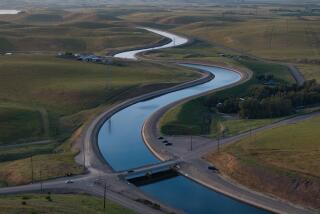Smaller Colorado River Surplus Predicted
In a finding that further complicates negotiations over a proposed Southern California water deal, a Caltech scientist has concluded that the Colorado River is entering a dry period and may not be as bountiful in coming decades.
The analysis, which was done by a researcher at Caltech’s Jet Propulsion Laboratory, seems to bolster the contention of the Metropolitan Water District of Southern California that the proposed billion-dollar agreement between Imperial County and San Diego County does not foresee a gusher of “surplus” water from the river.
“I think he’s right on point,” said Metropolitan Vice President Dennis Underwood. “We can say these things, but people say our motives aren’t pure. It helps to have reputable [outside] people look at the issues.”
Metropolitan officials have resisted arm-twisting by the state and federal governments to agree to allow the district’s Colorado Aqueduct to be used to bring some of Imperial Valley’s mammoth allocation of the Colorado River to arid San Diego County.
The Bush administration in early January suspended the flow of “surplus” water from the Colorado River to Metropolitan after the California agencies failed to meet a New Year’s deadline to agree on what would be the biggest sale of water from farms to cities in the nation.
The prospect of resuming such surplus allotments to Metropolitan, which serves 18 million people in six counties, is considered a major inducement to having the mega-agency drop its opposition. In recent years Metropolitan has received upward of 800,000 acre-feet of surplus water above its normal allocation each year, enough for 6 million people.
But the report done for Metropolitan by researcher William C. Patzert and released Tuesday suggested that there may be little surplus water available and thus little motivation for Metropolitan to sign.
In a breezy tone not often associated with the number-crunching reviews of temperature fluctuations and rainfall patterns, Patzert said he doubts that Southern California will enjoy the same frequency of the rain-filled El Nino storms as in the last 20 years. The result would be less water in the river that provides sustenance for seven Western states.
“Thus, don’t count on the next 13 years looking like the 1980s and 1990s,” Patzert wrote. “In the next decade or more, El Nino will have more of a tendency to be El No Show or El Wimpo.”
As talks have slowed recently , Metropolitan officials have raised the specter of Southern California taxpayers being soaked for hundreds of millions of dollars in environmental fix-up projects for the Salton Sea as part of the San Diego-Imperial deal, but not receiving much surplus water in return.
Federal law requires mitigation of environmental damage done by water sales. Since the sea survives on agricultural runoff, a sale of water from Imperial to San Diego would mean less runoff and a higher level of salinity in the sea.
Former Assemblyman Richard Katz, Gov. Gray Davis’s representative during on-again, off-again negotiations over the proposed deal, dismissed the Caltech report and said it does not change the governor’s position that the deal is vital to the state’s water future.
Estimates about rainfall and river levels “are best guesses at best,” Katz said. “Nobody guessed that rainfall in May would fill up Lake Oroville and Lake Shasta to the point where they are spilling over [with] water.”
He added that the San Diego-Imperial deal, which is called the Quantification Settlement Agreement by water insiders, “represents more than just surplus water. It represents peace on the river, peace in a water war that has been going on for 30 years.”
The agreement is meant to set limits on how much water can be drawn from the river by the Imperial Irrigation District and the Coachella Valley Water District for use in desert agriculture.
A decade in the making, it is also meant to show six other states that California can learn to live within a water budget by shifting water from farms to cities. To help that process, the six states are willing to give California 15 more years of surplus allocations.
Katz said he hopes that negotiations resume this week among Metropolitan, the Imperial district, the Coachella Valley district and the San Diego County Water Authority. Just last week, Katz and Assistant Interior Secretary Bennett Raley announced what they called a “milestone” in the negotiations.
But even as Katz and Raley were making their announcement in Sacramento, Metropolitan officials were circulating a memo to board members suggesting that negotiations were stalemated.
In San Diego, it is the firm belief among many civic officials that Metropolitan will never willingly agree to the deal because it would grant San Diego, Metropolitan’s largest and unhappiest customer, an alternative source of imported water, thus cutting into Metropolitan’s revenues.
San Diego now buys nearly all its water from Metropolitan. Under the proposed deal with Imperial, San Diego’s dependence on Metropolitan would lessen.
Dennis Cushman, assistant general manager of the San Diego district, said that by emphasizing only the uncertainty surrounding the issue of surplus water, Metropolitan is ignoring the larger issue of water being sent to San Diego County.
“We need to look at the long-term value” of the deal, Cushman said.
He said the new estimate about the prospect of surplus water on the river appears to contradict a more optimistic estimate from the Bureau of Reclamation, which controls the river.
In his study, Patzert suggested that other experts be contacted for contrary opinions. “I strongly recommend that different opinions be heard,” he wrote. “I can work with your staff to select such a panel. Be skeptical and cautious!”
More to Read
Sign up for Essential California
The most important California stories and recommendations in your inbox every morning.
You may occasionally receive promotional content from the Los Angeles Times.










